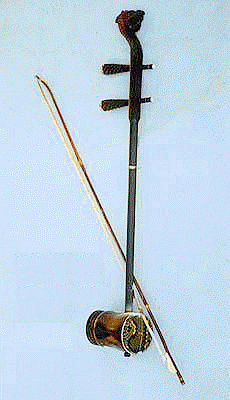 |
||||||||
HuQin |
||||||||
 |
Huqin (胡琴; pinyin: húqín) are a family of bowed string
instruments used in Chinese music. They consist of a round, hexagonal,
or octagonal sound box at the bottom with a stick attached that protrudes
upwards. Instruments in the huqin family normally have two strings (except
the sihu, which has four strings tuned in pairs), and their soundboxes
are typically covered with either snakeskin or thin wood. Huqin instruments have either two (or, more rarely, four) tuning pegs, one peg for each string. The pegs are attached horizontally through holes drilled in the stick. Most huqin have the bow hair pass in between the strings. The most common huqin are the erhu (essentially a Chinese violin), zhonghu (Chinese viola), and gaohu (a higher pitched instrument commonly used in Cantonese music.) Over thirty types of huqin instruments have been documented. Huqin instruments are believed to descend from an instrument called the xiqin (奚琴), originally played by the Xi, a nomadic people of Central Asia. The HuQin is not an instrument - it is a family of instruments. They are sometimes incorrectly referred to as a "ching-hu" or "hu ch'in" Pictured left is a GaoHu Similar instruments are also used in neighboring countries, such as Mongolia, Korea, Japan, Vietnam, Thailand, Laos, and Cambodia. Information extracts reproduced from Wikipedia under 'Collective Commons License' http://en.wikipedia.org/wiki/Huqin |
|||||||
|
||||||||